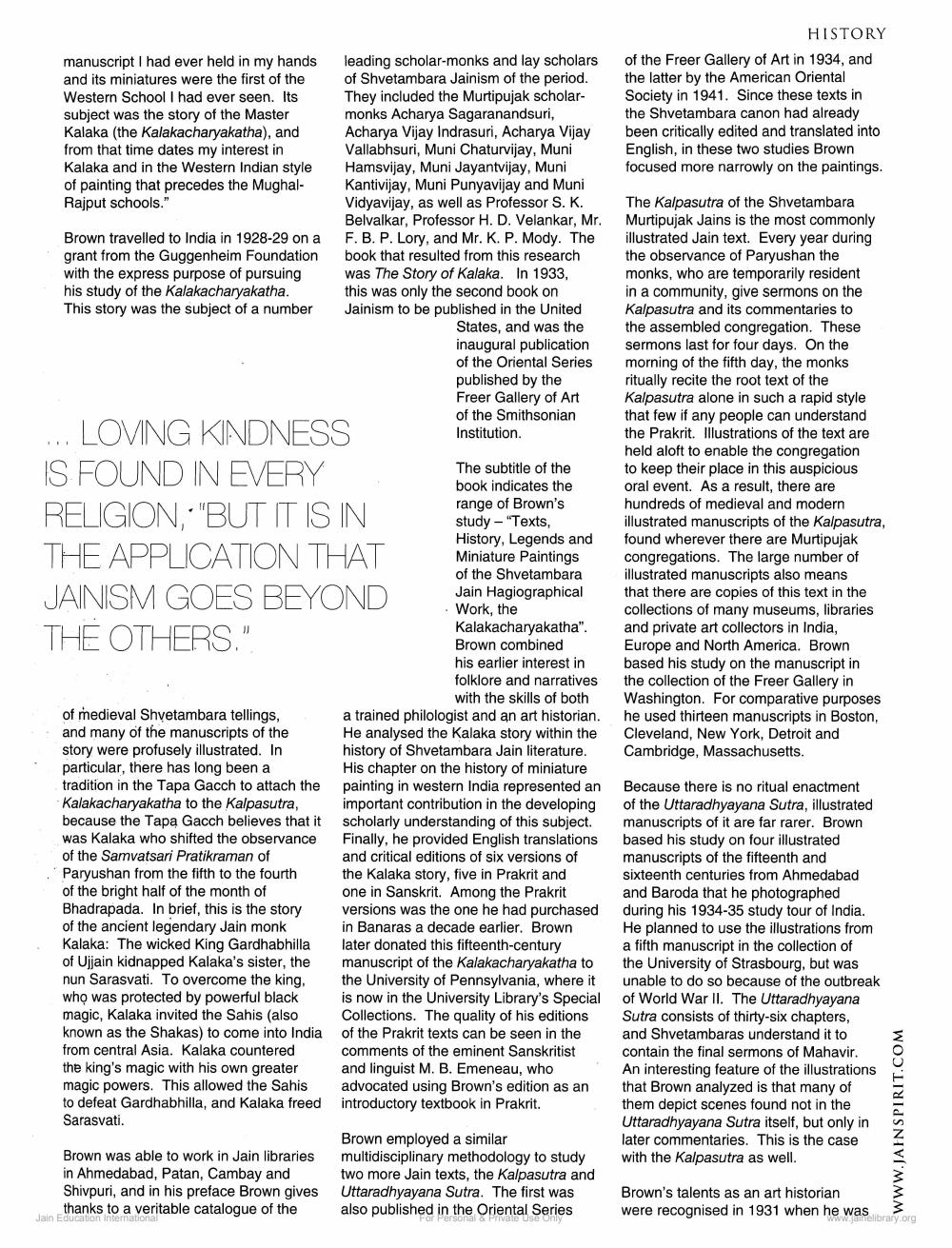________________
manuscript I had ever held in my hands and its miniatures were the first of the Western School I had ever seen. Its subject was the story of the Master Kalaka (the Kalakacharyakatha), and from that time dates my interest in Kalaka and in the Western Indian style of painting that precedes the MughalRajput schools."
Brown travelled to India in 1928-29 on a grant from the Guggenheim Foundation with the express purpose of pursuing his study of the Kalakacharyakatha. This story was the subject of a number
... LOVING KINDNESS
IS FOUND IN EVERY RELIGION, BUT IT IS IN
THE APPLICATION THAT JAINISM GOES BEYOND THE OTHERS."
of medieval Shvetambara tellings, and many of the manuscripts of the story were profusely illustrated. In particular, there has long been a tradition in the Tapa Gacch to attach the Kalakacharyakatha to the Kalpasutra, because the Tapa Gacch believes that it was Kalaka who shifted the observance of the Samvatsari Pratikraman of Paryushan from the fifth to the fourth of the bright half of the month of Bhadrapada. In brief, this is the story of the ancient legendary Jain monk Kalaka: The wicked King Gardhabhilla of Ujjain kidnapped Kalaka's sister, the nun Sarasvati. To overcome the king, who was protected by powerful black magic, Kalaka invited the Sahis (also known as the Shakas) to come into India from central Asia. Kalaka countered the king's magic with his own greater magic powers. This allowed the Sahis to defeat Gardhabhilla, and Kalaka freed Sarasvati.
Brown was able to work in Jain libraries in Ahmedabad, Patan, Cambay and Shivpuri, and in his preface Brown gives thanks to a veritable catalogue of the
leading scholar-monks and lay scholars of Shvetambara Jainism of the period. They included the Murtipujak scholarmonks Acharya Sagaranandsuri, Acharya Vijay Indrasuri, Acharya Vijay Vallabhsuri, Muni Chaturvijay, Muni Hamsvijay, Muni Jayantvijay, Muni Kantivijay, Muni Punyavijay and Muni Vidyavijay, as well as Professor S. K. Belvalkar, Professor H. D. Velankar, Mr. F. B. P. Lory, and Mr. K. P. Mody. The book that resulted from this research was The Story of Kalaka. In 1933, this was only the second book on Jainism to be published in the United States, and was the inaugural publication of the Oriental Series published by the Freer Gallery of Art of the Smithsonian Institution.
Jain Education International
The subtitle of the book indicates the range of Brown's study - "Texts, History, Legends and Miniature Paintings of the Shvetambara Jain Hagiographical Work, the Kalakacharyakatha". Brown combined his earlier interest in folklore and narratives with the skills of both
a trained philologist and an art historian. He analysed the Kalaka story within the history of Shvetambara Jain literature. His chapter on the history of miniature painting in western India represented an important contribution in the developing scholarly understanding of this subject. Finally, he provided English translations and critical editions of six versions of the Kalaka story, five in Prakrit and one in Sanskrit. Among the Prakrit versions was the one he had purchased in Banaras a decade earlier. Brown later donated this fifteenth-century manuscript of the Kalakacharyakatha to the University of Pennsylvania, where it is now in the University Library's Special Collections. The quality of his editions of the Prakrit texts can be seen in the comments of the eminent Sanskritist and linguist M. B. Emeneau, who advocated using Brown's edition as an introductory textbook in Prakrit.
Brown employed a similar multidisciplinary methodology to study two more Jain texts, the Kalpasutra and Uttaradhyayana Sutra. The first was also published in the Oriental Senes
HISTORY of the Freer Gallery of Art in 1934, and the latter by the American Oriental Society in 1941. Since these texts in the Shvetambara canon had already been critically edited and translated into English, in these two studies Brown focused more narrowly on the paintings.
The Kalpasutra of the Shvetambara Murtipujak Jains is the most commonly illustrated Jain text. Every year during the observance of Paryushan the monks, who are temporarily resident in a community, give sermons on the Kalpasutra and its commentaries to the assembled congregation. These sermons last for four days. On the morning of the fifth day, the monks ritually recite the root text of the Kalpasutra alone in such a rapid style that few if any people can understand the Prakrit. Illustrations of the text are held aloft to enable the congregation to keep their place in this auspicious oral event. As a result, there are hundreds of medieval and modern illustrated manuscripts of the Kalpasutra, found wherever there are Murtipujak congregations. The large number of illustrated manuscripts also means that there are copies of this text in the collections of many museums, libraries and private art collectors in India, Europe and North America. Brown based his study on the manuscript in the collection of the Freer Gallery in Washington. For comparative purposes he used thirteen manuscripts in Boston, Cleveland, New York, Detroit and Cambridge, Massachusetts.
Because there is no ritual enactment of the Uttaradhyayana Sutra, illustrated manuscripts of it are far rarer. Brown based his study on four illustrated manuscripts of the fifteenth and sixteenth centuries from Ahmedabad and Baroda that he photographed during his 1934-35 study tour of India. He planned to use the illustrations from a fifth manuscript in the collection of the University of Strasbourg, but was unable to do so because of the outbreak of World War II. The Uttaradhyayana Sutra consists of thirty-six chapters, and Shvetambaras understand it to contain the final sermons of Mahavir. An interesting feature of the illustrations that Brown analyzed is that many of them depict scenes found not in the Uttaradhyayana Sutra itself, but only in later commentaries. This is the case with the Kalpasutra as well.
Brown's talents as an art historian were recognised in 1931 when he was
www.JAINSPIRIT.COM
www.janelibrary.org




